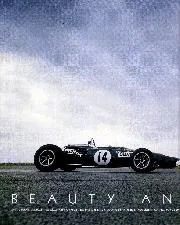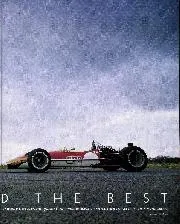

Eagle-Weslake T1G vs Lotus 49: Beauty and the Best
It's called an Eagle-Weslake T1G, completed just one full season of competition and is perhaps the most beautiful Grand Prix car ever built. From the curl of its exhausts to…
SPORTING CARS ON TEST.
THE 33-180 h.p. SUPERCHARGED iNIERCEDIIS. By THE EDITOR.
IT has seldom been my lot to try Out any really interesting car ; I have driven 70 m.p.h. Sports models— very safe, I have driven 50 m.p.h. touring models— very dangerous, but never, until I drove the big Mercedes, have I had even an inkling of what it must be like to handle a real racing car. From time to time in the motoring press furious arguments are waged as..to maximum speed and average reviews of the identical car which I sampled. One writer in particular emphasises again and again that while it would give him great satisfaction to know that his car is capable of 90-100 m.p.h., he would not dream of attempting any such speed under any circumstances whatsoever, save on the race track—goes on to say that the car has a delightful cruising speed of 60 m.p.h. and is ideal for traffic driving in the Metropolis. All this is
speed possible on the road. One school of thought finds it quite impossible to credit anyone with an average speed of more than 30 m.p.h. on a long run, or with a maximum speed of more than 60 m.p.h. on a public highway, while admitting that one or two complete lunatics may possibly approach these figures, at great risk to life and limb, and to the everlasting damnation of any good name that motorists can hope to hold. After a trial of the supercharged Mercedes, I should expect even the most ardent follower of this doctrine to be wholly converted from the folly of his beliefs— but no ! Before setting pen to paper on this fascinating subject, I casually glanced through one or two press
wasted breath and ink spilt in vain ; thousands of cars have a 4 m.p.h. top gear performance, and hundreds can do an effortless 60 m.p.h., but why the writer in question should recommend a £1,600 car for these purposes I cannot imagine. £500 will purchase a car with this performance. Obviously the man who desires a car like the Mercedes, and intends to use it as it should be used, is an enthusiast of the first water, and he would not be very disappointed if it was a trifle inflexible and harsh at low speeds. Imagine, then, his pleasure at finding that the car combines all the virtues of an electric sedan with the capabilities of a Grand Prix Winner !
It is no exaggeration to say that the 33-180 h.p. Mercedes is a car which fulfils both these requirements. Our trial embraced all conditions of road and street driving, and showed that for docility in traffic the ” Mere. ” was second to none, in spite of its phenomenal road devouring ability.
I have been accustomed to reasonably fast travelling, on motor-cycles and smaller cars, but quite frankly was a trifle doubtful as to the wisdom of exceeding 70 m.p.h. on an ordinary traffic-infested road. 80 m.p.h. on an uphill stretch, less than 20 miles from Hyde Park therefore, was something of an eye-opener, even to me, while to gentlemen of the breed referred to previously,— well, I think they would be afflicted with serious eye-lid trouble for life !
On the occasion of our trial we left Long Acre, en route for Coventry at 10.40 a.m., and naturally for some miles we were unable to sample any virtue of the ‘Mercedes which would not be shown by many inferior cirs, except perhaps for a wonderful booming drone in the exhaust note, which occurred only in the neighbourhood of 40 m.p.h. At all other speeds the exhaust note was completely unobtrusive, even to the specially tuned car of the police Force.
A slight indication of Mercedes power was granted on the climb up a bye road to Highgate, a gradient of about 1 in 7, which was surmounted at 60 m.p.h. from a slow start on top gear. The supercharger, which is brought into action by a complete depression of the throttle pedal, was used here, and even on top gear produced most satisfactory acceleration. Before going further it would be as well to mention a few points of the specification. Chief interest, of course, centres on the supercharger, which is driven by a multiple plate clutch off the front end of the crankshaft. In the normal way air is drawn to the carburettor through an intake, which allows either hot or cold air to be induced, but when the supercharger is engaged, the ordinary intake is blanked off by a
butterfly valve and the blower delivers air at from five to six pounds pressure into the carburettor. The overhead camshaft is driven by a vertical worm drive at the rear of the unit, and is hollow—oil being forced through and on to the working surfaces of the cams by way of suitable holes. Long rockers are interposed between the cams and the valve stems. The top half of the crankcase and cylinder block are cast in aluminium, liners being inserted as working surfaces for the pistons.
The springing is half elliptic throughout, and the four-speed box provides ratios of 3.28 to 1, 41 to 1, 7 to 1, and 111 to 1.
The Mercedes firm seem to have little to learn on points of durability of material, as after 23,000 miles, when this car was decarbonised, no valve grinding was necessary, and not even the valve clearances required adjustment.
To return to the open road, where this car surely belongs, we soon found that 90 m.p.h. was quite an ordinary speed for the” Merc. ” and we were continually subjected to irritating delays by lorries and wholly despicable road craft of the 60 m.p.h. maximum type ! At such speeds, braking and road holding must be judged by entirely their own standards, and I was forced to remind myself continuously that the car weighed 21 tons and that we were doing over 80 m.p.h. on a decidedly indifferent road, if for one moment I imagined that the car was becoming at all restive, or that the brakes were not adequate.
100!
We twice attained the level 100 m.p.h. on the only clear stretches of road encountered, and at this, and neighbouring speeds, although considerable concentration was desirable and necessary, the car required less effort to hold than any touring car at half the speed. Proportionately greater distances had to be allowed when slowing down, but in spite of being slightly out of adjustment the brakes really left nothing to be desired, always bearing in mind the speed and the weight of the car.
Corners could be treated with great contempt and the car evinced not the slightest suspicion of roll. Considering the lamentable state of the Coventry road and, once again, the indecent speeds indulged in, comfort was remarkable, so much so that we never gave it a thought while in the driver’s seat. In the rear seats, however, we found the conveniently placed hand grips distinctly useful ! Gear changing in an upward direction was easy, but when changing down, never really necessary, it was easy to make .a mistake, while unaccustomed, owing to the closeness of the ratios and the extreme liveliness of the engine. •However, after a little practice, a quiet change proved quite simple.
We eventually reached Coventry (90 miles) at 1 p.m., having strictly observed all 10 mile limits, having taken no risks, and having had one stop of five minutes. The return journey was made in almost identical time, again in spite of heavy traffic on the road. The petrol consumption varies from 11 to 14 m.p.g., according to. the speed, which, considering the engine capacity (6240 c.c.) and the performance, is distinctly .good.
SPORTING CARS ON TEST–continued. As will have been noted, the gear ratios are extremely well chosen, and in conjunction with an engine developing its maximum power at 3,000 r.p.m., enable the most
phenomenal road averages to be performed ; on our trial I did not indulge too much in this form of driving, as conditions would not allow it, but I can fully appreciate the of the car in
ate car this direction.
It is unlikely that I should have any criticism to offer of a car in this class, costing £1,650, as it does in chassis form, and although it is usual in press reports to pick at least one small hole in the subject, I must, for once, confess myself beaten.
All sportsmen who have the necessary means, let me earnestly entreat you, do not buy a car until you have experienced the joy of a hurricane dash in the Mercedes at 80 m.p.h., and listened to the fierce whine of the super-charger as you approach the century mark—you can only arrive at one conclusion—you will buy a Mercedes.